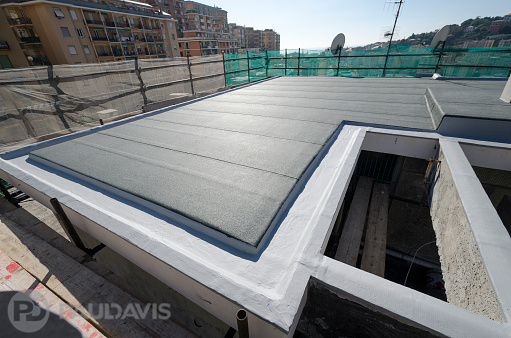
It’s no exaggeration to say that workplaces are only as functional as their roofs. A sturdy commercial roof protects valuable equipment, hard-working employees and work processes from the extremes of weather, literally enabling business to proceed under its protective shield. Commercial roofs can fail in small ways, such as a leak in the lunchroom after a thunderstorm, or large, as when hurricane winds expose a manufacturing area to the elements. When this happens, the question of repairing or replacing is easier to answer when businesses understand how these systems work and know the history of their own particular models.
Roofs for businesses are termed “flat” because this profile is the most economical and structurally feasible means of covering large areas, managing heat gain, providing safety features such as fire retardancy and resisting weather. Materials like asphalt, tar, rubber membranes, gravel and waterproofing are often layered on a reinforced foundation that has been specifically engineered to support these heavy substances. Perimeter or interior drainage systems remove water channeled to specific locations by the roof’s nearly imperceptible sloping. In short, these roofs are very technical systems that are custom built by highly knowledgeable companies to suit specific structures.
Retaining a qualified, expert roofing contractor with experience in a variety of roofing systems is the first line of defence in cases of failure. Ideally, this contractor is familiar with a company’s specific roofing system and has performed routine inspections and maintenance over its lifetime, both of which are critical to extending the roof’s longevity. These roofing specialists – many of whom offer 24/7 emergency coverage – inspect the failure and recommend one or more of three actions:
- Repair: After taking emergency action to protect company assets, contractors assess next steps. If the roof has not reached its life expectancy, is structurally sound and does not have a history of failures, it’s likely that repairs will completely solve this problem. Contractors may advise additional repairs and specific maintenance to avoid future failures.
- Restoration: Most commercial roofing systems require restoration during their lifetimes because materials are subject to extreme temperatures – dark roofs can reach 200 degrees Fahrenheit, for instance – and degradation inevitably occurs. If the roof is structurally sound and has not reached its recommended life expectancy, many contractors address failures – and prevent future problems – by performing a complete restoration.
- Replacement: If the roof has a history of failures, is becoming structurally unsound or is reaching the end of its life expectancy, replacement may be the only option. Because replacement is costly, many contractors offer programs that manage a failing roof and enable a business to budget a future planned replacement.
Paul Davis is another important resource for addressing commercial roofing failure and damaged assets.
